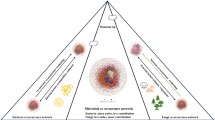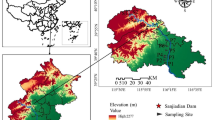Abstract
Using TABORD five Schoenus ferrugineus associations have been distinguished from the literature. They are well distinguished by differential-species combinations and most of them are described earlier under identical names, e.g., the Primula-, Oxycoccus-, Myrica-, and Trichophorum-Schoenus ferrugineus ass. The Thalictrum-Schoenus ferrugineus ass. is a new syntaxon. They are further characterized by different floristic elements according to their geographical distribution. The Primula-Schoenus ferrugineus ass. is related to Central Europe, the Primulo-Schoenetum ferruginei from Oberd. (1957) 1962. All other associations discussed have no counterparts elsewhere in Europe. The shortcoming of this classification and the impossibility of a syntaxonomical ranking are emphasized.
The variation in species composition and site conditions is elucidated by RA ordination. A complex soil moisture gradient is related to the differences in species composition between the Primula-, Oxycoccus-, and Myrica-Schoenus ferrugineus ass. Wet topogenous mire sites with peat formation and a rather low pH is typical of the Myrica-Schoenus ferrugineus ass., while the Primula-Schoenus ferrugineus ass. occurs either in moist soligenous mire sites or in to pogenous sites with strongly shifting water tables and with muck (Anmoor) instead of peat. The site conditions of the Oxycoccus-Schoenus ferrugineus ass. are most similar to those of the Myrica-Schoenus ferrugineus ass. The Trichophorum- and Thalictrum-Schoenus ferrugineus ass. occur on soligenous mire sites.
Similar content being viewed by others
References
AdamP., 1977. On the phytosociological status of Juncus maritimus on British saltmarshes. Vegetatio 35: 81–84.
AlbertsonN., 1942. Selaginella selaginoides (L.) Link. i södra och mellersta Sverige. Svensk Bot. Tidskr. 36: 86–94.
AlbertsonN. & LarssonB. M. P., 1960. Bidrag till kännedom om Saxifraga hirculus-myren Sjöängens växtsamhällen. Bot. Notiser 113: 353–372.
AuneE. I., 1969. Vegetasjon og flora i Hemne og Snillfjord, Sør-Trøndelag, (Vegetation and flora in Hemne and Snillfjord, Central Norway). Blyttia 27: 194–202.
BeeftinkW. G., 1968. Die Systematik der europäischen Salzpflanzengesellschaften. In: R.Tüxen (ed.) Pflanzensoziologische Systematik, p. 239–263. Junk, The Hague.
BondeL. & NilssonÅ., 1971. Vegetationsundersökningar i Gökastorpskärren på Billingen. Trebetygsuppsats i System. Botanik, Göteborgs Univ. Göteborg, Mimeogr. 72 pp.
Booberg, G., 1930. Gisselåsmyren. En växtsociologisk och utvecklingshistorisk monografi över en jämtländsk kalkmyr. Norrländskt Handbibliotek 12. Uppsala. 329 pp.
Braun, W., 1968. Die Kalkflachmoore und ihre wichtigsten Kontaktgesellschaften im Bayerischen Alpenvorlande. Dissert. Bot. I. Cramer, Lehre, 134 pp.
BraunW., 1970. Bestimmungsübersicht für die Kalkflachmoore und deren wichtigsten Kontaktgesellschaften im Bayerischen Alpenvorlande. Ber. Bayr. Bot. Ges. 42: 109–138.
Braun-Blanquet, J., 1971. Übersicht der Pflanzengesellschaften der rätischen Alpen im Rahmen ihrer Gesamtverbreitung. III. Flachmoorgesellschaften (Scheuchzerio-Caricetalia fuscae). Veröff. Geobot. Inst. Eidg. Tech. Hochsch. Stift. Rübel 46. Zürich. 63 pp.
Du RietzG. E., 1949. Huvudenheter och huvudgränser i svensk myrvegetation (Main units and main limits in Swedish mire vegetation). Svensk Bot. Tidskr. 43: 274–309.
EllenbergH., 1974. Zeigerwerte der Gefässpflanzen Mitteleuropas. Scripta Geobot. 9: 1–95. Göttingen.
Faegri, K., 1944. On some finds of Schoenus ferrugineus in Western Norway. Bergens Mus. Årbok. Naturv. rekke 6. Bergen. 16 pp.
Flatberg, K. I., 1970. Nordmyra, Trondheim. Aspekter av flora og vegetasjon. I. Hovedfagopgave i spec. botanikk Univ. Trondheim. Mimeogr. 183 pp.
FranssonS., 1965. The Borderland. Acta Phytogeogr. Suec. 50: 167–175.
FrisvollA. A. & MoenA., 1980. Lophozia borealis sp. nov., a rich fen hepatic from Fennoscandia. Lindbergia 6(2): 137–146.
GörsS., 1964. Beiträge zur Kenntnis basiphiler Flachmoorgesellschaften (Tofieldietalia Prsg. apud Oberd. 49). 2. Das Mehlprimel-Kopfbinsen-Moor (Primulo-Schoenetum ferruginei Oberd. (57) 62). Veröff. Landesst. für Naturschutz und Landschaftspflege, Baden-Würtemberg, 32: 1–42. Ludwigsburg.
GörsS., 1975. Cladietum marisci All. 1922 in Süddeutschland. Beitr. Naturk. Forsch. Südw-Deutschl. 34: 103–124. Karlsruhe.
HaslamS. M., 1965. Ecological studies in the Breck Fen. I. Vegetation in relation to habitat. J. Ecol. 53: 599–619.
HillM. O., 1973. Reciprocal averaging: an eigenvector method of ordination. J. Ecol. 61: 237–249.
HoldgateM. W., 1955a. The vegetation of some springs and wet flushes on Tarn Moor near Orton, Westmoreland. J. Ecol. 43: 80–89.
HoldgateM. W., 1955b. The vegetation of some British Upland fens. J. Ecol. 43: 390–403.
HulténE., 1950/1971. Atlas över växternas utbredning i Norden. (Atlas of the distribution of vascular plants in North-western Europe). 1st and 2nd ed. Generalstabens Litografiska Anstalt, Stockholm. 531 pp.
JørgensenP. M., 1969. Bidrag till Rogalands flora (Contribution to the flora of Rogaland, Norway). I. Blyttia 27: 18–25.
Kask, M., 1965. Vegetation fo the Avaste Mire of West Estonia. (Russian, English summary). Akad. Nauk Est. SSR Zool. Bot. 538, Tartu. 100 pp.
KlossK., 1965. Schoenetum, Juncetum subnodulosi und Betula pubescens-Gesellschaften der kalkreichen Moorniederungen Nordostmecklenburgs. Beitr. zur Vegetationsk. 7: 65–117. (=Feddes Rep. Beih. 142).
Klötzli, F., 1969. Die Grundwasserbeziehungen der Streu- und Moorwiesen im nördlicher Schweizer Mittellande. Beitr. Geobot. Landesaufnahme der Schweiz, 52. Bern. 296 pp.
KorneckD., 1963. Die Pfeifengraswiesen und ihre wichtigsten Kontaktgesellschaften in der nördlicher Oberrheinebene und in Schweinfurter Trockengebiet. III. Kontaktgesellschaften. Beitr. Naturk. Forsch. Südw-Deutschl. 22: 165–190 Karlsruhe.
KovásM., 1962. Die Moorwiesen Ungarns. In: B.Zólyomi (ed.) Die Vegetation ungarischer Landsehaften. 3. Ungar. Akad. Wissensch. Budapest. 214 pp.
Laasimer, L., 1965. Eesti NSV taimkate (Vegetation of the Estonian SSR. Summary). Tallin. 398 pp.
LangerH., 1958. Die Vegetationsverhältnisse des Benninger Riedes und ihre Verknüpfung mit der Vegetationsgeschichte des Memminger Tales. Bot. Jahrb. 77: 355–422. Stuttgart.
Larsson, B. M. P., 1967. Trädgårdstorpskärret-ett Schoenus kärr söder om Kinnekulle. Skaraborgsnatur, 1967: 7–13. Lidköping.
LippmanT., 1931. Beiträge zur Kenntnis der Flora und Vegetation südwest-Estlands. Acta Inst. et Horti Botan. Univ. Tart. (Dorpat.), II (3–4): 1–253. Tartu.
LjungquistJ. E., 1929. Vegetationsbilder från Mästermyr. 3. Svensk Bot. Tidskr. 23: 219–232.
Løjtnant, B. & Worsøe, E., 1977. Foreløbig status over den danske flora. Rep. Bot. Inst. Univ. Aarhus, 2. Aarhus.
MaarelE.van der, JanssenJ. G. M. & LouppenJ. W. M., 1978. TABORD, a program for structuring phytosociological tables. Vegetatio 38: 143–156.
Masing V., 1975. Mire typology of the Estonian SSR. In: Laasimer et al. (ed.) Some aspeets of botanical research in the Estonian SSR. p. 123–136. Acad. of Sciences of the Eston. SSR. Tartu.
Mathiesen, B., 1957. Malaxis paludosa og Schoenus ferrugineus i Hølonda traktene. (Malaxis paludosa and Schoenus ferrugineus in the Hølonda district, Norway), K. Nor. Vidensk. Selsk. Mus. Årbok 1956–1957: 95–101. Trondheim.
Moen, A., 1969. Subajpine slåttemyrer på Nordmarka-Nordmøre. In: Myrers økologi og hydrologi. IHD rapport 1: 66–74. Oslo.
Moen, A., 1970. Myr og kildevegetasjon på Nordmarka-Nordmøre. Hovedfagoppgave i spec. botanikk, Univ. Trondheim. Mimeogr.
MoenA., 1973. Erfaringer fra vegetasjonskartleggingen i Trøndelagsområdet med hovedvekt på myrenhetene. IBP i Norden, 11: 93–109. Oslo.
Nordhagen, N., 1937. Versuch einer neuen Einteilung der subalpinen-alpinen Vegetation Norwegens. Bergens Mus. Årbok 1936, Naturv. 7. Bergen. 88 pp.
Oberdorfer, E., 1957. Süddeutsche Pflanzengesellschaften. Pflanzensoziologie 10. Jena. 564 pp.
Paasio, J., 1939. Zur Vegetation der eigentlichen Hochmoore Estlands. Ann. Bot. Soc. ‘Vanamo’ 11: 2. 114 pp.
Pettersson, B., 1958. Dynamik och konstans i Gotlands flora och vegetation. Acta Phytogeogr. Suec. 40. 288 pp.
RatcliffeD. A., 1964a. Mires and bogs. In: J. H.Burnett (ed.) The vegetation of Scotland, p. 426–478. Oliver & Boyd, Edinburgh.
RateliffeD. A., 1964b. Montane mires and bogs. In: J. H.Burnett (ed.) The vegetation of Scotland, p. 536–538. Oliver & Boyd, Edinburgh.
Roskam, E. E., 1971. Program ORDINA. Multidimensional ordination of observation vectors. Program-Bulletin 16. Dept. Meth. Psychology, Univ. Nijmegen. 8 pp.
Runge, F., 1973. Die Pflanzengesellschaften Deutschlands. Aschendorf, Münster. 246 pp.
RuuhijärviR., 1960. Über die regionale Einteilung der nordfinnischen Moore. Ann. Bot. Soc. ‘Vanamo’ 31(1): 1–306.
SjörsH., 1946. Myrvegetationen i Övre Långanområdet. Ark. f. Bot. 33(6): 1–96. Stockholm.
Sjörs, H., 1948. Myrvegetation i Bergslagen. (Mire vegetation in Bergslagen, Sweden). Acta Phytogeogr. Suec. 21. 299 pp.
SjörsH., 1950. Regional studies in North Swedish mire vegetation. Bot. Notiser 103: 173–222.
SjörsH., 1956. Nordisk Växtgeografi, Scand. Univ. Books, Stockholm. 229 pp.
SkogenA., 1965. Flora og vegetasjon i Ørland herred, Sør-Trøndelag (Flora and vegetation in Ørland district, Central Norway). K. Nor. Vidensk. Selsk. Årbok 1965: 13–124. Trondheim.
SkogenA., 1966. Noen plantefunn fra Trøndelagskusten. II. Blyttia 24: 81–92. Oslo.
Skogen, A., 1969. Trekk av noen oseaniske myrers vegetasjon og utvikling. In: Myrers økologi og hydrologi. IHD rapp. 1: 88–95. Oslo.
SkogenA., 1970. Plantegeografiske undersøkelser på Frøya, Sør-Trøndelag. III. Alpine og nordlige innsiag i floran. Blyttia 28: 108–124. Oslo.
Suarskis, P., 1941. Die Verbreitung der Sesleria coerulea ssp. uliginosa Celakowsky in Litauen. Script. Hort. Bot. Univ. Vilnensis I. Wilna. (Not available for checking, but cited by Görs 1964).
TomsonA., 1937. La végétation de la presqu'ile de Sôrve (Estonie). (Estonian. French summary). Acta Inst. et Horti Bot. Univ. Tart. IV(1): 1–87. Tartu.
TrassH., 1957. The Schoenus swamps in the Estonian SSR. (Estonian, English summary). Eesti NSV Tead. Akad. Toim. Biolog. 6: 134–144. Tallin.
TrassH. & MalmerN., 1978. North European approaches to classification. In: R. H.Whittaker (ed.). Classification of Plant communities 203–245. Junk, The Hague.
Tyler, C., 1975. The calcareous fen of Örup. Its vegetation, previous history and future management. (Swedish, English summary). Medd. Ekol. Bot. Lunds Univ. Årg. 3 Nr. 9. Lund. 64 + 7 pp.
Tyler, C., 1979a. Comments on vegetation and environment of Schoenus sites in South and Southeast Sweden. Meddn Växtekol. Inst. Lunds Univ. 38. Lund. 24 + 36 pp.
TylerC., 1979b. Classification of Schoenus communities in South and Southeast Sweden. Vegetatio 41: 69–84.
TylerC., 1979c. Schoenus vegetation and environmental conditions in South and Southeast Sweden. Vegetatio 41: 155–170.
WaldheimS., 1949. Ett kalkkärr vid Örups almskog. Skånes Natur 36: 81–94. Lund.
WaldheimS. & WeimarckH., 1943. Bidrag till Skånes flora 18. Skånes myrtyper. (Scanian mire types). Bot. Notiser 96: 1–40.
WalterH. & StrakaH., 1970. Einführung in die Phytologie. III: 2 Arealkunde. Floristisch-historische Geobotanik. Ulmer, Stuttgart. 478 pp.
WesthoffV. & HeldA. J.den, 1969. Planten-Gemeenschappen in Nederland. Thieme & Cie, Zutphen. 324 pp.
WheelerB. D., 1980. Plant communities of rich-fen systems in England and Wales. II. Communities of calcareous mires. J. Ecol. 68: 405–420.
Zobrist, L., 1935. Pflanzensoziologische und bodenkundliche Untersuchungen des Schoenetum nigricantis im nordostschweizerischen Mittellande. Beitr. zur Geobot. Landesaufnahme der Schweiz; 18. Bern. 144 pp.
Author information
Authors and Affiliations
Additional information
Nomenclature of species and syntaxa as in Tyler (1979b).
My gratitude to Professors N. Malmer, E. van der Maarel, H. Sjörs, and G. Tyler, amanuenses A. Moen and K. I. Flatberg, Mrs Ülle-Reet Tsirk and Mimmi Varga for advices and help with material and manuscript is gratefully expressed.
Rights and permissions
About this article
Cite this article
Tyler, C. Geographical variation in Fennoscandian and Estonian Schoenus wetlands. Vegetatio 45, 165–182 (1981). https://doi.org/10.1007/BF00054672
Accepted:
Issue Date:
DOI: https://doi.org/10.1007/BF00054672




